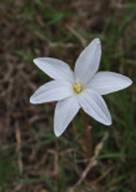by Charlie Grindstaff
We moved to our five acres of heaven on Valentine’s Day back in 1990. That spring we identified 66 species of wildflowers growing in the back uncivilized acres. We practically wore out our copy of Wildflowers of Texas by Geyata Ajilvsgi.
We walked almost every day with that book in hand looking for new discoveries and recording them. We congratulated ourselves on having purchased paradise.
This went on until sometime in July when we went out on
a day after it had rained. There in our lawn under the Bradford pear were two white flowers we had not previously seen. We had never thought of searching our front yard for wildflowers, but upon closer inspection we found maybe a dozen scattered around.
Each was a six-petalled, solitary, fragrant bloom atop a 10” leafless stem. Per Ajilvsgi they were Evening-Star Rain Lilies (Cooperia drummondii). The blooms only lasted a couple of days and then they were gone leaving behind a green seed pod.
The next time we had a good rain a new crop of rain lilies magically appeared in our yard. We noticed that they appeared after most rainstorms but they almost never appeared after we watered the lawn. How could they possibly know the difference between rain water and tap water?
I really like “magic” and am very happy to use that explanation, especially when I don’t think I will like or understand the real answer.
We have worried about the rain lilies this summer with the record-breaking heat and lack of rain. I am very happy to report that the magic is still here. We have had lovely rain lilies bloom after both showers we received recently.
The species name honors Thomas Drummond (ca.1790-1835), a botanist from Scotland who came to Texas in 1833 and collected 750 species of plants and 150 specimens of birds in less than two years.
Rain lilies are perennials and may be cultivated. They naturalize very easily in grass and tolerate mowing. The flowers open in the late afternoon or evening. They bloom from June to September, typically immediately after a rain following a dry period.
Common names include fairy lily, rainflower, zephyr lily, magic lily, and rain lily. They are found in Arkansas, Kansas, Louisiana, Mississippi, New Mexico, Oklahoma and Texas, as well as Northern Mexico.



